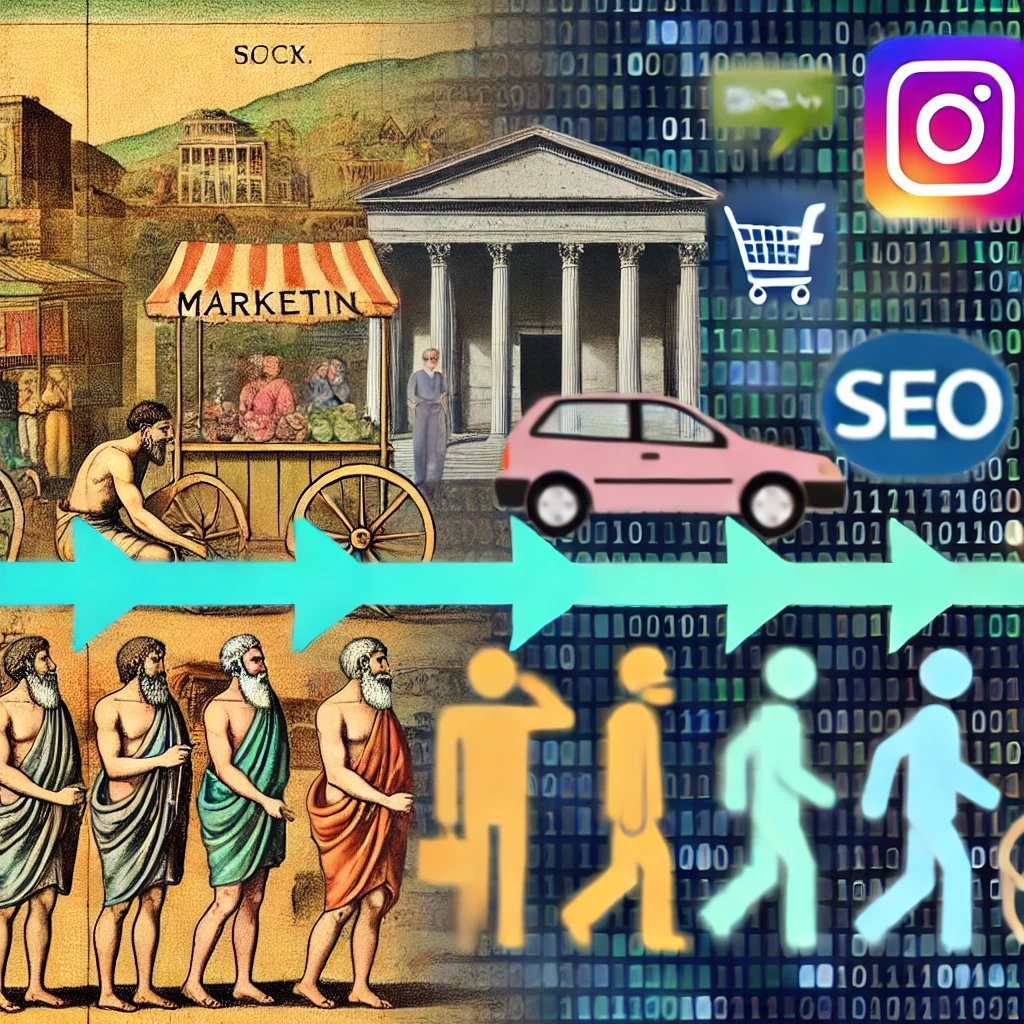It has been ingrained in the fabric of trade since long before the formal principles of business and marketing were recognised or understood. Over the centuries, as societies progressed and economies evolved, we’ve collectively amassed knowledge and gleaned insights from past endeavours, allowing us to refine and enhance our understanding of marketing strategies.
From the rudimentary barter exchanges of early civilizations to the sophisticated advertising campaigns of the digital age, the evolution of marketing mirrors the broader arc of human civilization. We have witnessed the emergence of new mediums, from simple word-of-mouth recommendations to elaborate social media platforms, each presenting unique opportunities and challenges for marketers to navigate.
Through trial and error, experimentation, and innovation, we’ve honed our techniques, developing strategies that are not only effective but also efficient in reaching and resonating with target audiences. Thanks to our educators who provide a space to learn all about the world of marketing, whether through a specialised classroom setting or an online MBA, interested individuals and businesses can really benefit from learning about the craft.
Today, marketing encompasses a diverse array of disciplines, including market research, branding, advertising, and customer relationship management, all working in tandem to create compelling narratives and experiences that drive consumer engagement and loyalty.
The Early Days: From Barter to Bazaars
In the earliest human societies, marketing was a simple affair centred around the exchange of goods through barter systems. People relied on word-of-mouth recommendations and personal relationships to facilitate transactions, with little need for formal marketing strategies.
As civilizations began to flourish, however, so too did the need for more sophisticated marketing techniques. The rise of marketplaces and bazaars in ancient cities like Athens and Rome marked a significant turning point in the evolution of marketing, providing merchants with a centralised location to showcase their wares and attract potential buyers.
These bustling hubs of commerce became fertile ground for early marketing tactics, with vendors employing various techniques to stand out from the competition. From eye-catching signage to persuasive sales pitches, merchants sought innovative ways to capture the attention of passersby and entice them to make a purchase.
The Industrial Revolution: From Local Markets to Mass Production
The advent of the Industrial Revolution brought about seismic changes in the world of marketing, as mass production and distribution transformed the way goods were manufactured and sold. With the rise of factories and assembly lines, products could be produced on a scale never before seen, leading to an explosion in consumer choice and availability.
This newfound abundance of goods posed a challenge for marketers, who now had to find ways to differentiate their products in an increasingly crowded marketplace. Advertising emerged as a powerful tool for reaching mass audiences, with newspapers, magazines, and billboards becoming popular mediums for promoting products and services.
During this period, branding also began to play a more prominent role in marketing, as companies sought to cultivate distinctive identities and foster brand loyalty among consumers. Iconic logos and slogans became synonymous with quality and reliability, helping to establish trust and credibility in the minds of customers.
The Golden Age of Advertising: From Mad Men to Mainstream Media
The mid-20th century witnessed the rise of advertising as a dominant force in the world of marketing, thanks in large part to the proliferation of television and radio. With the advent of these new mediums, advertisers gained unprecedented access to mass audiences, allowing them to create compelling narratives and messages that resonated with consumers on a profound level.
This era also saw the emergence of the modern advertising agency, with firms like J. Walter Thompson and Leo Burnett leading the way in crafting innovative campaigns for some of the world’s biggest brands. The iconic “Mad Men” of Madison Avenue became synonymous with creativity and sophistication, shaping the way advertising was perceived and practised for decades to come.
Meanwhile, advancements in market research and consumer psychology provided marketers with valuable insights into the motivations and behaviours of their target audiences. Techniques like focus groups and surveys allowed companies to better understand the needs and desires of consumers, enabling them to tailor their marketing efforts accordingly.
The Digital Revolution: From Traditional Media to the World Wide Web
The creation of the internet in the late 20th century heralded a new era of marketing, as digital technologies reshaped the way companies interacted with consumers. With the rise of websites, email, and social media platforms, marketers gained unprecedented access to vast networks of potential customers, enabling them to reach audiences with unprecedented precision and efficiency.
This shift towards digital marketing brought about a host of new opportunities and challenges for businesses, as they grappled with the complexities of online advertising and e-commerce. Search engine optimization (SEO), pay-per-click (PPC) advertising, and social media marketing have become essential tools for reaching and engaging with consumers in an increasingly crowded online marketplace.
At the same time, the rise of data analytics and machine learning ushered in a new era of precision marketing, allowing companies to track and analyse consumer behaviour in real time. This data-driven approach enabled marketers to deliver highly targeted and personalized experiences to individual customers, fostering deeper connections and driving increased loyalty and engagement.
Looking to the Future: Trends and Innovations in Marketing
As we look ahead to the future of marketing, several key trends and innovations are poised to shape the industry in the years to come. From the continued growth of digital marketing to the rise of experiential and immersive technologies, marketers will need to stay ahead of the curve to remain competitive in an ever-changing landscape.
One of the most significant trends in recent years has been the growing importance of sustainability and social responsibility in marketing. Consumers are increasingly conscious of the environmental and social impact of their purchasing decisions, and companies that demonstrate a commitment to sustainability stand to gain a competitive advantage in the marketplace.
Advancements in artificial intelligence (AI) and automation are poised to reform the way marketers interact with customers, allowing more personalised and seamless experiences across a variety of touchpoints. From chatbots and virtual assistants to predictive analytics and recommendation engines, AI-powered technologies have the potential to transform every aspect of the marketing process.
Constant Change
The evolution of marketing is a testament to the ingenuity and adaptability of human beings. From humble beginnings in the markets and bazaars of ancient civilizations to the digital age of today, marketing has evolved into a sophisticated and multifaceted discipline that plays a crucial role in driving business success. It’s clear that the only constant in the world of marketing is change, and those who embrace it will be best positioned to thrive in the years to come. By examining this evolutionary journey, we gain valuable insights into the past, present, and future of marketing, illuminating the path forward as we continue to innovate and redefine the ways in which we connect with and influence consumers.











